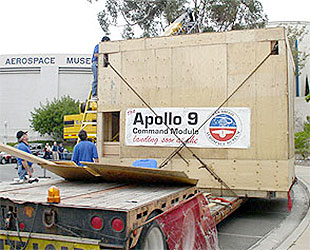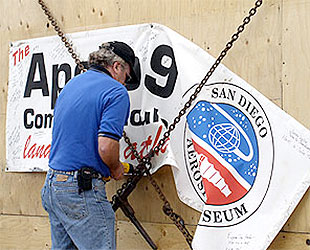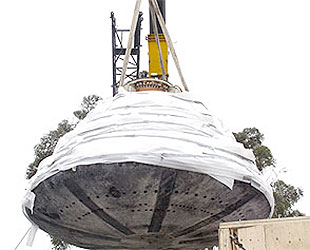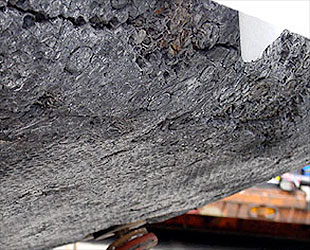 advertisements advertisements
|

|
Full Coverage: Apollo 9 lands in San Diego
by Francis French, collectSPACE contributor
Museum prepares Apollo 9 for display
July 18, 2004 — After its delivery in late May at the San Diego Aerospace Museum, the Apollo 9 command module "Gumdrop" was hidden from view behind other exhibits in a dark corner of a gallery. Looking inside the capsule, the couches and banks of switches appeared almost sinister in the shadow. Last week, the museum began preparing the spacecraft for public debut this Tuesday (July 20).
Click on thumbnails to enlarge
More photographs below.
Held on its underside attachment points on a specially angled movable metal support, the Apollo 9 capsule was carefully moved through the museum on the evening of June 15. It was a tight fit to take it through the existing space exhibits — a glass window had to be disassembled as a result — but all else went to plan. By the morning before the museum's doors opened, Apollo 9 was sitting in the museum's bright and airy front rotunda.
It was still not ready for public exhibit, however. The spacecraft still needs to have a custom-built display zone assembled around it. The hatch will be off, and the public will be able to step up and look in through a Plexiglass window. A red light under the spacecraft will simulate the fiery heat of re-entry. Behind Apollo 9 will be a special exhibit, including the spacecraft's hatch, that will help to explain the 1969 mission and its historic achievements.
Apollo 9 itself is in remarkably good condition considering the decades since it flew. When looking into the hatch, the spacecraft's interior appears clean and bright, as if it had just rolled off the North American production line and is ready to fly. Some dust trapped between the inner and outer windows is the only obvious sign of the long years of display. The rotation control handle is a replica, as are the crew couches (which were apparently recycled for use on Apollo 10), but the rest of the interior is original.
With the protective coverings not yet installed and the entire spacecraft visible, the evidence of Apollo 9's fiery reentry is immediately obvious. Most interestingly, the aft heatshield is far more charred on the side opposite the hatch — evidence of the angled reentry Apollo spacecraft made. Circling Apollo 9, there is a good deal of variance in the condition of the crew compartment heatshield. In some places, the Kapton polymide tape thermal coating is completely intact. Elsewhere, the white moisture barrier coating is evident, with minor bubbling. Only in very few places is the underlying resin heatshield apparent. It is a stark difference from other displayed spacecraft such as Apollo 10 and 11, which have been stripped down to only their resin coatings.
Other details are apparent on close inspection: umbilical wiring cut where the Command and Service modules separated; irregularities in the heatshield where fixes were made in the manufacturing process; evidence of panels removed for post-flight inspection. Sadly, also evident are large depressed strips on the heatshield — the spacecraft apparently was kept on its original transportation pallet for many years after recovery, and the indentations are now permanent. One of the reasons the San Diego Aerospace Museum was chosen as Apollo 9's new home was for their ability to display the spacecraft more appropriately, with the care and attention required.
Gumdrop's hatch is still cradled in a special packing box in the museum's basement. It had been on display in Japan for many years, and time has not been kind to it. Whether due to postflight inspection or lack of proper care the hatch window is missing, as are the release handles, control levers, actuating handles and other equipment that was used to open the hatch when it was installed on the spacecraft. Nevertheless, having the two together in the same display is quite a coup for the museum.
On July 21st, Apollo 9 will be unveiled to the public in a grand opening. Over the two preceding evenings, special sneak preview events featuring astronauts and other space notables will begin to build the excitement leading to the big day on Wednesday.
Click on thumbnails to enlarge
Apollo 9 spacecraft lands in San Diego

The Apollo 9 command module, inside its wooden crate, arrives at the San Diego Aerospace Museum in California. (Sophia Lopez) |
May 26, 2004 — A spacecraft landed in San Diego today.
Fortunately, it was expected — and rather than coming from outer space, its arrival was considerably less exotic — by way of flatbed truck from Michigan.
The Apollo 9 Command Module travelled from the now closed Michigan Space and Science Center in Jackson, to its new home at the San Diego Aerospace Museum in California, 35 years after it flew in space.
Transporting the national treasure cross-country required an almost equal degree of care as if it was returning from Earth orbit. A custom-made, 14-foot wooden crate with foam padding for the capsule's heatshield was specially constructed — though not for Apollo 9. In a coincidence of timing, the crate had been built in Canada to deliver the Apollo 7 Command Module to Texas. Once it had arrived in Dallas earlier this month, the crate was off to Michigan to be reused for Apollo 9.

The sign on the side of the spacecraft's crate was signed by those who encountered the Apollo 9 capsule on its trip. (Sophia Lopez) |
Last week, with Aerospace Museum representatives in Michigan, Apollo 9 — named by its crew "Gumdrop" — was loaded into the crate on the back of a flatbed truck. On each side of the crate was a vinyl color sign, to let people know what was being carried inside.
As the truck passed through various states on its way to California, curious onlookers came to see the crate and wanted to see the spacecraft inside. Truckers reportedly took delight in calling on the CB radio, shouting out "I'm being chased by a spacecraft!"
The truck was only allowed to drive from dawn until dusk, and had to stop every night. No security was provided for Gumdrop but the drivers had two dogs which, chained to the outside of the truck, provided a deterrent for anyone thinking to break into the crate for a peek at its contents.
Besides, it would have been difficult to walk off with the 11,000 pound capsule.
That said, one of the crate's signs was taken, though ironically, it was by a lawman. One evening, the drivers were trying to beat the sunset, hoping to reach one more town before stopping for the night. They didn't quite make it; a police officer pulled them over for driving in the dark. About to ticket them, he instead grew fascinated when hearing what they were carrying. As opposed to a fine, he asked for the sign as a souvenir.
The other sign was autographed along the way by the people who came to see the crate as it passed through their town. Many good luck wishes were written on the sign, and also on the wooden box.

Apollo 9 "Gumdrop" is removed its shipping crate by crane at the San Diego Aerospace Museum. (Sophia Lopez) |
Finally, at ten this morning, the flatbed pulled up to the back of the museum in San Diego. Workers carefully pried off a wooden panel from the side, revealing the familiar shape that had given Gumdrop its name, though the craft itself was hidden in plastic wrap secured by ribbons of duct tape. The top of the crate was the next section to be loosened, after which a large crane pulled the wooden slats away. The padding around the top of the spacecraft was gently peeled away, revealing a glimpse of Apollo 9 to those assembled.
The crane next lowered chains to the crate, which were attached to the spacecraft anchor points that had once held the escape tower in place. Slowly, carefully, Apollo 9 emerged into the California sunshine. Although all of the Apollo capsules had been built in southern California, this was the first one to return for display for many years. For the museum's directors, which had been trying to obtain one for almost as long, it was the end of a long process.
Looking into the empty crate and at the spent foam padding, a small number of tiny heatshield chunks were evident, scattered randomly. Looking at Gumdrop, as the it hung over the parking lot, it was evident why small pieces might come off despite the care taken — the edge of the heatshield was raggedly scorched in places, with many loose-looking corners. Apollo 9 had taken quite a beating on re-entry, and the effects are still very evident.

Close-up of the Apollo 9 spacecraft heatshield. (Sophia Lopez) |
The spacecraft was then gently lowered to hang from the front of a forklift truck, which took it into the museum. Over the next five days, glass windows and exhibits will be moved out of the way as it shuffles into the building's main entrance rotunda. It is planned that Gumdrop will be prepared for exhibit behind a screen in this area, before a public unveiling coinciding with the 35th anniversary of the Apollo 11 flight, July 21, 2004.
Museum staff hope that Apollo 9 crewmembers James McDivitt, Russell "Rusty" Schweickart and David Scott will make an appearance for this event, though plans are still being finalized.
The success of the ten-day Apollo 9 mission in March 1969 paved the way for the Apollo 10 crew to take the Lunar Module within nine miles of the Moon's surface as a "dress rehearsal" for the successful landing of Apollo 11 on July 20, 1969. |

© collectSPACE. All rights reserved.

|
|

|

|
